‘The National 2021: New Australian Art’ is on until September across three separately curated venues in Sydney: the Art Gallery of New South Wales, the Museum of Contemporary Art and Carriageworks. It’s the last in a series of three biennial exhibitions presenting the work of artists who were either born in Australia or who currently work here; there has already been a ‘National 2019’ and a ‘National 2017’. This one is inevitably framed by pandemic circumstances that have prohibited most international visitors and isolated artists and audiences, as well as by the drought, fires and floods that have so badly affected the country in the last two years. ‘The National 2021’ takes planetary crisis as its premise, and ‘care’ as one of its main subjects. Indigeneity is central, not just in the choice of artists, but also as a way of thinking differently about the exhibition’s concerns, such as artistic collaboration, social responsibility, relationship to the land, intergenerational learning and healing.
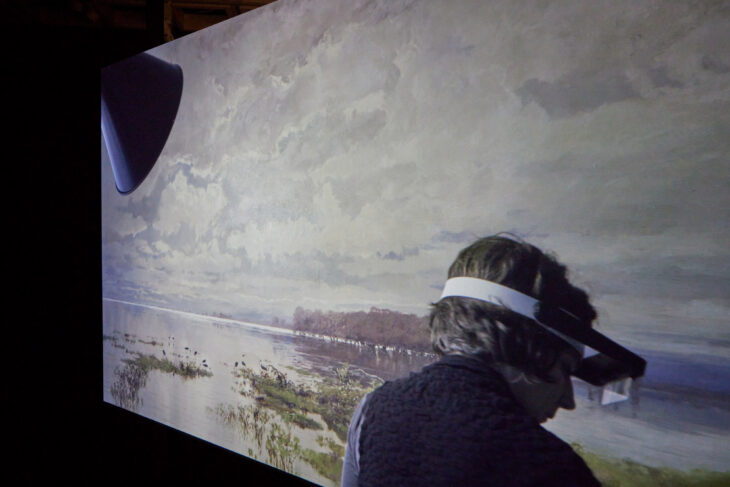
Darling Darling (installation view; 2021), Gabriella Hirst. Photo: AGNSW/Felicity Jenkins; Courtesy the artist, the Ian Potter Cultural Trust and the Australian Centre for Moving Image (ACMI); © the artist
There’s no getting around the art world’s historic and continuing complicity with the forces these themes bring to the fore. Some of these contradictions are neatly expressed in Darling Darling, a two-channel video installation by Gabriella Hirst at the Art Gallery NSW. Two large screens hang back to back. On one, we see the dried-up bed of the Darling – or Barka – river system, filmed by a static camera at different sites along its lengths. There’s the faint sound of birds calling. These landscape shots are composed in the picturesque style of 19th-century painting, but the river and associated ecosystem they depict have been devastated by poor management and drought exacerbated by climate change. On the other side is a short film showing scenes from the conservation of The Flood in the Darling, a late 19th-century painting by the Australian landscape artist W.C. Piguenit. It is beautifully produced (by the veteran film-maker Bridget Ikin). The camera is trained on the scuffs, grazes and spots on the magnified surface of the painting. Later we stare at some lint from a conservator’s Q-tip sitting on top of the painting’s gilt frame. Flimsy sheets of gold leaf are carefully applied to the frame with a soft brush. You can hear the birds calling from the other side of the screen as we are shown the minute grooves on the painting’s surface left by a dead artist’s brush, painstakingly swabbed clean now with infinite care.
How much more attention do we pay to art than to the things it represents and claims to love, suggests Hirst, disproving Ruskin’s suggestion that landscape painting makes us pay closer attention to the land itself and love it more. We have made the Darling dear through painting but effectively destroyed it in reality. A woman sits with a small child – her grandson perhaps – in front of the film. Look, she says, it’s the Flooding of the Darling. That was one of the first paintings the Gallery bought. Simon is the chief conservator. The painting is one of the first the Gallery bought. The child, understandably, is not particularly interested. Some sort of instrument spins and bangs loudly in a conservator’s retort just as the birdsong crescendos on the other side of the screen. It hurts my ears, says the child. Oh I doubt that, the woman replies, returning his attention to the painting they are looking at on screen.

Ngangkari Ngura (Healing Country) (2020), Betty Muffler and Maringka Burton. Photo: AGNSW/Felicity Jenkins; courtesy the artists and Iwantja Arts; © the artists
A different kind of care, Indigenous care for country, haunts Darling Darling. Care of water has been a first principle of an Indigenous relationship to land for thousands of years. It was the Barkindji elder Uncle Badger Bates who advised Hirst where to film along the river that runs through his country, like those places where the mussels are exposed and dying, and which places to avoid, too sacred to be shown. Indigenous care for country – and its not altogether happy translation into what we recognise as art – is also shown through the work of Betty Muffler and Maringka Burton, whose collaborative paintings dominate the main atrium of the Art Gallery of New South Wales. Downstairs in the gallery we can see a film made about these women – aunt and niece – as they walk around their country and talk about their work as healers and painters. We help people who have lost their spirit, they tell us.
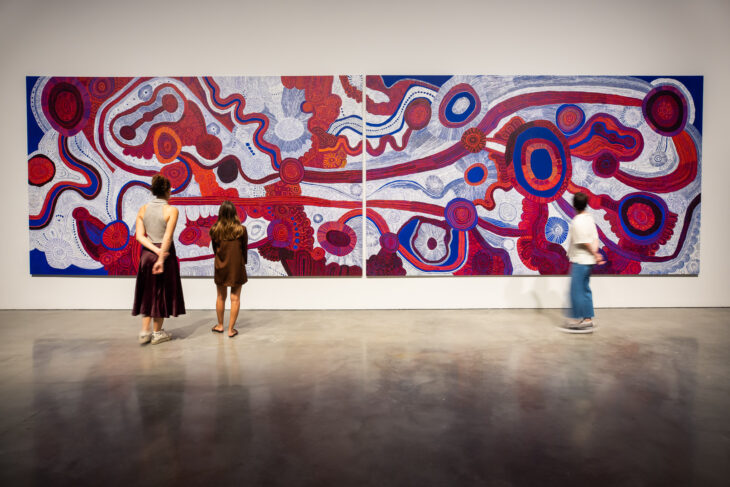
Antara (2020), Betty Kuntiwa Pumani; installation view at ‘The National 2021: New Australian Art’ at Museum of Contemporary Art Australia, Sydney. Photo: Anna Kucera; courtesy and © the artist
It’s the work at the Museum of Contemporary Art that makes the biggest visual impression. Betty Kuntiwa Pumani’s huge Antara, representing her mother’s country in the Anangu Pitjantjatjara Lands, is spectacular in its limited palette of red, blue and white. Maree Clarke’s necklaces made of echidna quills, river reeds and kangaroo teeth lift the spirits. So too does the work gathered together by artist Deborah Kelly, part of a plan to invent a new religion called Creation, with the help of strangers and friends, among them artists, musicians, poets, choreographers and anyone willing to dance. At the MCA are costumes and headdresses, collages, film of performances and workshops, and a two-channel animation called The Gods of Tiny Things. May we know our bodies as technologies in the service of the Great Work of Pleasure, scrolls a text on a screen. Huge grasshoppers in high heels boot-scoot across an ultramarine background. It’s magnificent. May we learn from bacterium size does not equate to power. The text is the Liturgy of the Saprophyte, we’re told, by S.J. Norman, a Wiradjuri artist and writer. I look up ‘saprophyte’ and see it is the name given to an organism that feeds on dead and decaying matter. We venerate the Holy Order of the Fungus, runs the text. So do I, after seeing footage of mushrooms that can digest crude oil. Ave, Mycelium. This is great. We the Carnate children of Burning Empires pack our wounds with ash. A video shows you how to do a Creation dance, accompanied by pounding music.
‘The National 2021: New Australian Art’ is at Art Gallery of New South Wales (until 5 September), Museum of Contemporary Art Australia (until 22 August) and Carriageworks (until 20 June).
Unlimited access from just $16 every 3 months
Subscribe to get unlimited and exclusive access to the top art stories, interviews and exhibition reviews.

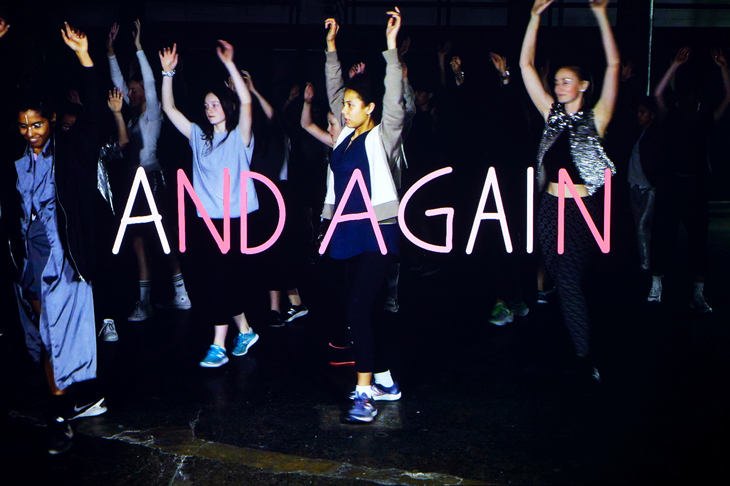
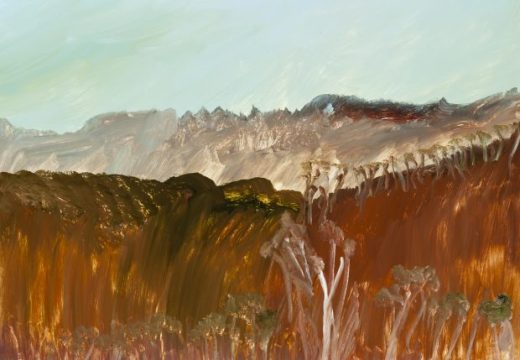
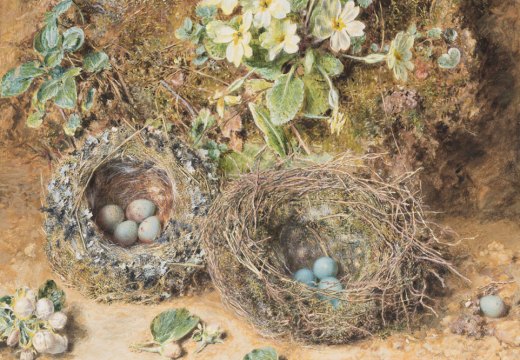
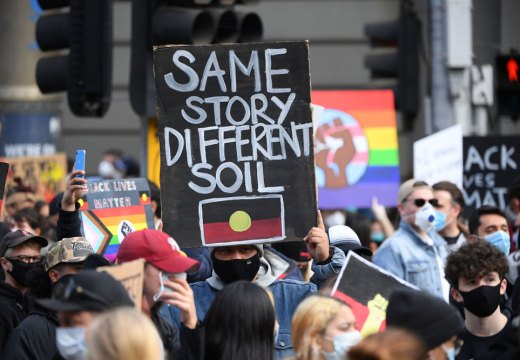









![Masterpiece [Re]discovery 2022. Photo: Ben Fisher Photography, courtesy of Masterpiece London](http://www.apollo-magazine.com/wp-content/uploads/2022/07/MPL2022_4263.jpg)
It’s time for the government of London to return to its rightful home